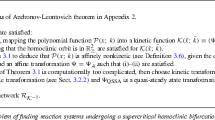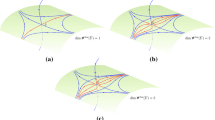Abstract
The analysis of dynamic of chemical reaction networks by computing Hopf bifurcation is a method to understand the qualitative behavior of the network due to its relation to the existence of oscillations. For low dimensional reaction systems without additional constraints Hopf bifurcation can be computed by reducing the question of its occurrence to quantifier elimination problems on real closed fields. However deciding its occurrence in high dimensional system has proven to be difficult in practice. In this paper we present a fully algorithmic technique to compute Hopf bifurcation fixed point for reaction systems with linear conservation laws using reaction coordinates instead of concentration coordinates, a technique that extends the range of networks, which can be analyzed in practice, considerably.
Access this chapter
Tax calculation will be finalised at checkout
Purchases are for personal use only
Preview
Unable to display preview. Download preview PDF.
Similar content being viewed by others
References
El Kahoui, M., Weber, A.: Deciding Hopf bifurcations by quantifier elimination in a software-component architecture. Journal of Symbolic Computation 30(2), 161–179 (2000)
Tarski, A.: A Decision Method for Elementary Algebra and Geometry, 2nd edn. University of California Press, Berkeley (1951)
Sturm, T., Weber, A., Abdel-Rahman, E., El Kahoui, M.: Investigating algebraic and logical algorithms to solve Hopf bifurcation problems in algebraic biology. Mathematics in Computer Science 2(3) (2009), Special Issue on Symbolic Computation in Biology
Clarke, B.L.: Stability of Complex Reaction Networks. Advances in Chemical Physics, vol. XLIII. Wiley Online Library (1980)
Gatermann, K., Eiswirth, M., Sensse, A.: Toric ideals and graph theory to analyze Hopf bifurcations in mass action systems. Journal of Symbolic Computation 40(6), 1361–1382 (2005)
Shiu, A.J.: Algebraic methods for biochemical reaction network theory. Phd thesis, University of California, Berkeley (2010)
Pérez Millán, M., Dickenstein, A., Shiu, A., Conradi, C.: Chemical reaction systems with toric steady states. Bulletin of Mathematical Biology, 1–29 (October 2011)
Wagner, C., Urbanczik, R.: The geometry of the flux cone of a metabolic network. Biophysical Journal 89(6), 3837–3845 (2005)
Gawrilow, E., Joswig, M.: Polymake: a framework for analyzing convex polytopes. In: Kalai, G., Ziegler, G.M. (eds.) Polytopes—Combinatorics and Computation. Oberwolfach Seminars, vol. 29, pp. 43–73. Birkhäuser, Basel (2000), 10.1007/978-3-0348-8438-9_2
Sturm, T.F., Weber, A.: Investigating Generic Methods to Solve Hopf Bifurcation Problems in Algebraic Biology. In: Horimoto, K., Regensburger, G., Rosenkranz, M., Yoshida, H. (eds.) AB 2008. LNCS, vol. 5147, pp. 200–215. Springer, Heidelberg (2008)
Dolzmann, A., Sturm, T.: REDLOG: Computer algebra meets computer logic. ACM SIGSAM Bulletin 31(2), 2–9 (1997)
Sturm, T.: Redlog online resources for applied quantifier elimination. Acta Academiae Aboensis, Ser. B 67(2), 177–191 (2007)
Weispfenning, V.: The complexity of linear problems in fields. Journal of Symbolic Computation 5(1&2), 3–27 (1988)
Weispfenning, V.: Quantifier elimination for real algebra—the quadratic case and beyond. Applicable Algebra in Engineering Communication and Computing 8(2), 85–101 (1997)
Dolzmann, A., Sturm, T.: Simplification of quantifier-free formulae over ordered fields. Journal of Symbolic Computation 24(2), 209–231 (1997)
Brown, C.W.: QEPCAD B: A system for computing with semi-algebraic sets via cylindrical algebraic decomposition. ACM SIGSAM Bulletin 38(1), 23–24 (2004)
Reidl, J., Borowski, P., Sensse, A., Starke, J., Zapotocky, M., Eiswirth, M.: Model of calcium oscillations due to negative feedback in olfactory cilia. Biophysical Journal 90(4), 1147–1155 (2006)
Larhlimi, A.: New Concepts and Tools in Constraint-based Analysis of Metabolic Networks. Dissertation, University Berlin, Germany
Dräger, A., Rodriguez, N., Dumousseau, M., Dörr, A., Wrzodek, C., Keller, R., Fröhlich, S., Novère, N.L., Zell, A., Hucka, M.: JSBML: a flexible and entirely Java-based library for working with SBML. Bioinformatics 4 (2011)
Hucka, M., Smith, L., Wilkinson, D., Bergmann, F., Hoops, S., Keating, S., Sahle, S., Schaff, J.: The Systems Biology Markup Language (SBML): Language Specification for Level 3 Version 1 Core. In: Nature Precedings (October 2010)
Domijan, A., Kirkilionis, M.: Bistability and oscillations in chemical reaction networks. Journal of Mathematical Biology 59(4), 467–501 (2009)
Gatermann, K., Huber, B.: A family of sparse polynomial systems arising in chemical reaction systems. J. Symb. Comp. 33, 275–305 (2002)
Seiler, W.: Involution — The Formal Theory of Differential Equations and its Applications in Computer Algebra. Algorithms and Computation in Mathematics, vol. 24. Springer, Heidelberg (2009)
Author information
Authors and Affiliations
Editor information
Editors and Affiliations
Rights and permissions
Copyright information
© 2012 Springer-Verlag Berlin Heidelberg
About this paper
Cite this paper
Errami, H., Seiler, W.M., Eiswirth, M., Weber, A. (2012). Computing Hopf Bifurcations in Chemical Reaction Networks Using Reaction Coordinates. In: Gerdt, V.P., Koepf, W., Mayr, E.W., Vorozhtsov, E.V. (eds) Computer Algebra in Scientific Computing. CASC 2012. Lecture Notes in Computer Science, vol 7442. Springer, Berlin, Heidelberg. https://doi.org/10.1007/978-3-642-32973-9_8
Download citation
DOI: https://doi.org/10.1007/978-3-642-32973-9_8
Publisher Name: Springer, Berlin, Heidelberg
Print ISBN: 978-3-642-32972-2
Online ISBN: 978-3-642-32973-9
eBook Packages: Computer ScienceComputer Science (R0)




